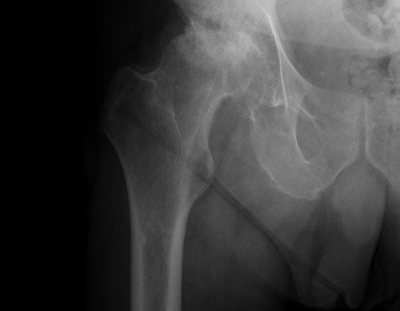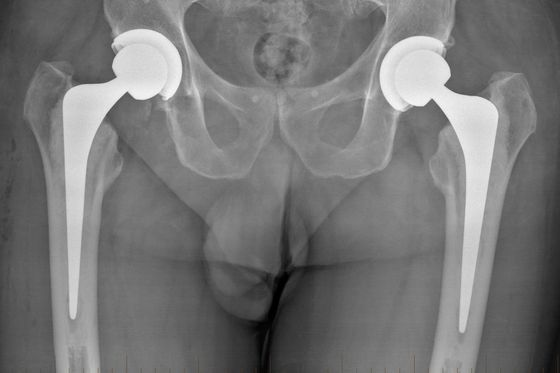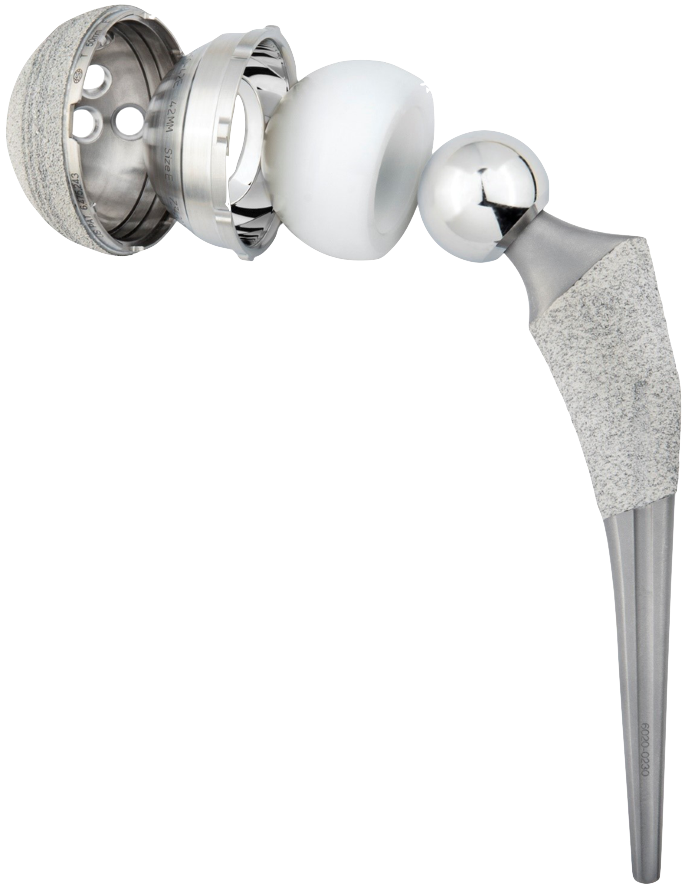Hip Replacement Surgery
What is Hip Replacement Surgery?
Hip replacement surgery, also known as total hip arthroplasty, is a surgical procedure that involves the replacement of the hip joint with an artificial joint made up of metal, ceramic, or plastic components. The surgery relieves pain and improves mobility in patients with hip arthritis or hip fractures.
The artificial device (prosthesis) replaces the worn-out ball and socket. The targeted results are:
- Relieve Pain & Stiffness
- Restore Mobility
- Regain Function
- Allow Resumption Of A Normal Lifestyle
A hip replacement is one of the most successful operations that any orthopaedic surgeon does and, once done, should last for decades (90% are still functioning after 20 years).
Who is a Candidate for Surgery?
Hip replacement surgery is typically recommended for patients with hip arthritis or hip fractures that cause severe pain and limited mobility. Surgery is usually considered when non-surgical treatments, such as medication, physical therapy, or assistive devices, fail to relieve symptoms. Candidates for hip replacement surgery must also have good overall health and be willing to follow the post-operative rehabilitation program.
Most hip replacement candidates are adults with degenerative disorders over 50.
What are the Benefits of Hip Replacement Surgery?
Hip replacement surgery offers many benefits for patients with hip pain and stiffness. The surgery can help to:
- Significantly reduce or eliminate hip pain, allowing patients to engage in their daily activities without discomfort.
- Improve hip joint function and mobility, allowing patients to walk, climb stairs, and perform other activities that were previously difficult or impossible.
- Improve the quality of life for patients, allowing them to enjoy activities they previously could not, such as sports, travel, and hobbies.
- Provide long-lasting relief from hip pain and stiffness, with many patients experiencing significant improvement in their hip function for 15 to 20 years or more.
Hip Surgery Recommendation
Once you and your surgeon have agreed on Hip Replacement Surgery, they will often discuss the options available, depending on your preferences. These may include the:
- Specific surgery type,
- Hip implant,
- Surgery Approach, and
- Surgery Method
These recommendations and the ideal approach to the hip depending on the individual patient’s anatomy, and your doctor will advise you of the most appropriate hip replacement approach
Hip surgery aims to return patients to their previous activity level with a fully functioning pain-free hip joint. It is possible that this may result in a return to high-impact and velocity sports, e.g. running, skiing, and tennis but cannot be guaranteed as it depends on a host of factors ,both surgical and non-surgical.

Hip Replacement Approaches
There are three main surgical approaches for Hip Replacement Surgery. The different surgical approaches vary in several ways but essentially come down to the way a surgeon cuts the soft tissues to get to the hip.The main approaches are Posterior (through the back of the hip), Anterior (through the front of the hip ) and Lateral (through the side of the hip).
Dr.Rajesh uses the Direct Lateral Hardinge approach for all hip replacements.
A well-done hip replacement is a fantastic operation, in terms of pain relief and improved quality of life, regardless of which approach is used.
Hip Replacement Implants
There are many different types of artificial joint prostheses, all made from different materials and offering different bearing surfaces.
- Traditional Implants
- Dual Mobility Implants - suitable for both Posterior and Anterior approaches.
Surgical Methods
Robotic Assisted Orthopaedic Surgery
Accurate alignment of the hip components is critical to the overall function and improved outcomes after Hip surgery.
Your doctor employs Computer-assisted surgery (CAS) that utilises robotic or image-guided technologies that help to accurately pinpoint anatomical landmarks.
Further, the system can help navigate different bone cuts and implantation alignment.


Preparation for Hip Replacement Surgery
Patients should take certain steps to prepare for the procedure and ensure a successful outcome. These steps include:
- Medical Evaluation: Patients should undergo a thorough medical evaluation to determine if they are suitable candidates for the surgery and identify any underlying health conditions that may affect the procedure's outcome.
- Lifestyle Changes: Patients should make certain lifestyle changes, such as quitting smoking, losing weight, and improving their diet, to reduce the risk of complications and ensure a speedy recovery.
- Pre-operative Rehabilitation: Patients should engage in pre-operative rehabilitation, such as physical therapy, to improve hip strength and flexibility and prepare for post-operative rehabilitation.
Hip Replacement Procedure
Hip Replacement involves removing existing arthritis and placing a metal cup in the socket and a metal stem down the femur.
Here are the steps involved in a posterior hip replacement procedure:
- Anaesthesia: The patient is given general or regional anaesthesia to ensure they are comfortable and pain-free during the surgery.
- Incision: The surgeon makes an incision at the side of the hip joint through the surrounding muscles and tissues.
- Dislocation of the Hip Joint: The surgeon dislocates the hip joint by rotating the leg outward from the hip socket, exposing the damaged parts of the joint.
- Removal of Damaged Tissue: The surgeon removes the damaged parts of the hip joint, including the ball and socket, using specialised instruments.
- Placement of Artificial Components: The surgeon implants the artificial components, consisting of a metal or ceramic ball and a plastic socket, into the hip joint, securing them with cement or press-fit techniques.
- Closing the Incision: The surgeon closes the incision with stitches or staples and applies a dressing.
What to Expect After a Hip Replacement Surgery?
After a hip replacement surgery, patients typically stay in the hospital for a few days to ensure a successful recovery. During this time, patients can expect the following:
- Pain Management: Patients will receive pain medication to manage discomfort and prevent complications.
- Physical Therapy: Patients will undergo physical therapy to improve hip strength and flexibility and prepare for post-operative rehabilitation.
- Assisted Mobility: Patients may require assistive devices like walkers or crutches to help them move around safely.
- Post-operative Rehabilitation: Patients will receive a post-operative rehabilitation plan, including exercises and activities to help them recover and regain mobility.
Hip Replacement Surgery Recovery Plan
The recovery period after a hip replacement surgery typically takes around six to twelve weeks, depending on the patient's age, health, and other factors. During this period, patients should follow the post-operative rehabilitation plan and make certain lifestyle changes to ensure a successful recovery. These changes may include:
- Physical Therapy: Patients should continue physical therapy to improve hip strength and flexibility and restore mobility.
- Activity Modification: Patients should avoid high-impact activities like running and jumping and modify their daily activities to reduce strain on the hip joint.
- Medications: Patients may need pain medication, blood thinners, and antibiotics to prevent infections and other complications.
- Follow-up Appointments: Patients should attend follow-up appointments with their surgeon to monitor their progress and ensure a successful recovery.
- Nutrition: Patients should eat a healthy and balanced diet to promote healing and prevent infections.
- Emotional Support: Patients may require emotional support from their family, friends, or a support group, to cope with the physical and emotional challenges of the recovery process.
Hip Replacement Surgery Risks
Like any surgery, hip replacement surgery involves certain risks and complications. Some potential risks and complications associated with hip replacement surgery include
- Infection
- Blood Clots
- Dislocation
- Leg length discrepancy
- Implant Failure
- Nerve or Blood Vessel Damage
It is essential to discuss the potential risks and complications of hip replacement surgery with your surgeon and follow their post-operative instructions carefully to minimise the risk of complications.
Hip Replacement Surgery Prognosis
Hip replacement surgery is a highly successful procedure that can significantly relieve hip pain and stiffness. According to the American Academy of Orthopaedic Surgeons, more than 95% of patients who undergo hip replacement surgery experience significant improvement in their hip function and pain relief. The longevity of the artificial joint depends on several factors, such as the patient's age, activity level, and general health. The artificial joint can generally last for 15-20 years or longer with proper care and follow-up appointments.
What if Hip Replacement Surgery is Delayed?
Delaying hip replacement surgery can result in prolonged pain and stiffness, reduced mobility, and increased risk of complications. It is essential to discuss the benefits and risks of delaying hip replacement surgery with your surgeon to determine the best course of action. In some cases, delaying surgery may lead to more significant health complications and reduced quality of life, so it is important to weigh the pros and cons carefully.



